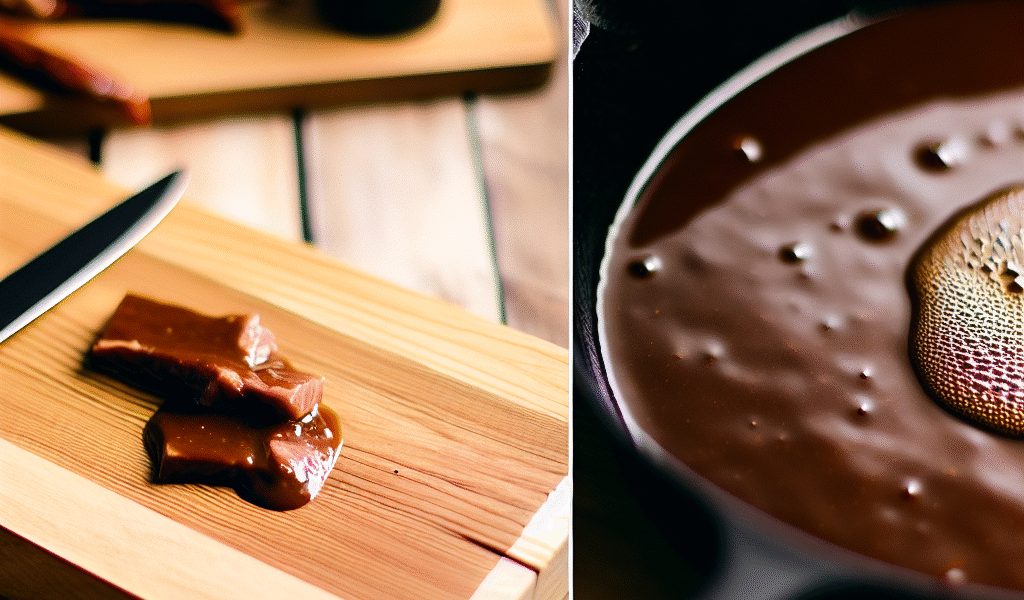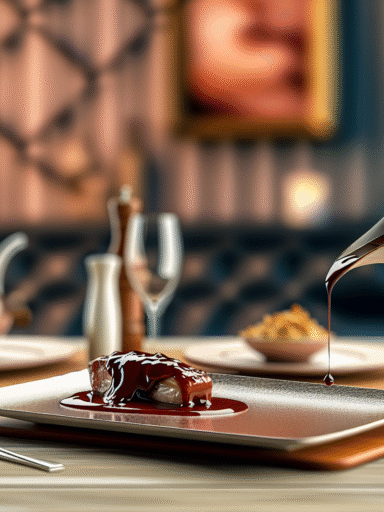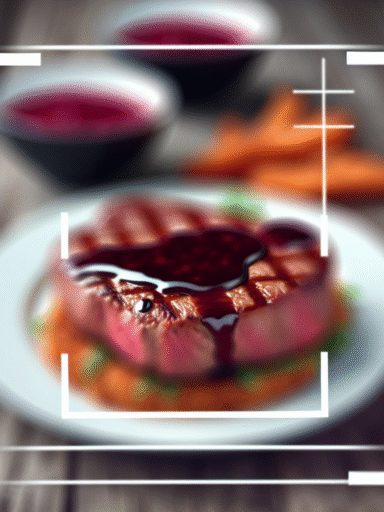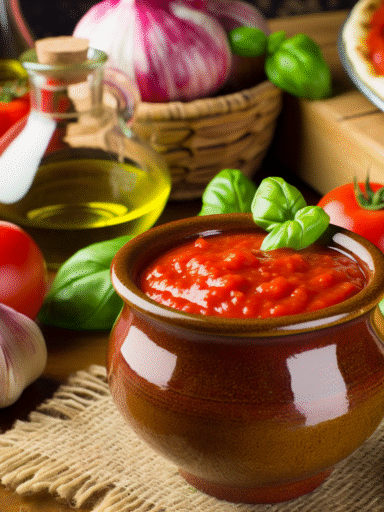Demi-Glace
If you’ve ever wondered what gives classic French dishes that deep, rich, and silky sauce, you’re looking at Demi-Glace. This traditional brown sauce packs a punch of intense flavor and velvety texture that elevates any meal – from a humble roast to an elegant beef Wellington. It takes time and love, but trust me, your kitchen will smell amazing right about now.
Tags / Categories
- Flavor Profile: Rich, savory, umami, slightly sweet
- Main Ingredients: Veal or beef stock, brown roux, red wine, aromatic vegetables
- Region: French cuisine, classic French sauces
- Usage: Sauce base for meats, stews, gravies, and reductions
Quick Info Box
- Prep Time: 20 minutes
- Cook Time: 3-4 hours (mostly simmering)
- Total Time: 3 – 4 hours 20 minutes
- Difficulty Level: Intermediate
- Yield: About 4 cups (1 liter) of demi-glace
Ingredients List
- 4 lbs beef or veal bones (preferably roasted)
- 2 cups finely chopped carrots
- 2 cups finely chopped onions
- 1 cup finely chopped celery
- 4 cloves garlic (optional, for a mild twist)
- 2 tablespoons tomato paste
- 1 cup dry red wine (Cabernet Sauvignon or Burgundy works well)
- 10 cups brown stock (veal or beef stock)
- 4 tablespoons unsalted butter
- 4 tablespoons all-purpose flour
- 2 sprigs thyme
- 2 sprigs parsley
- 1 bay leaf
- Salt and pepper to taste
Mastering the Art of Demi-Glace
Making demi-glace is a bit of a labor of love. It starts with the backbone: a deeply roasted bone stock that carries the flavor. Roasting those beef or veal bones until beautifully caramelized sets the stage for all those rich notes to develop. Next comes simmering those bones with classic French aromatics—carrots, onions, celery (mirepoix) and a touch of garlic if you like—to extract every ounce of flavor. Toss in tomato paste for sweetness and acidity, plus a good glug of red wine to deepen the complexity.
While the stock is simmering gently for a few hours, keep an eye on it and skim off any foam or fat. This part requires patience, but it’s where the magic builds, as the liquid reduces to a concentrated depository of savory goodness. In the meantime, whip up a brown roux—equal parts butter and flour browned until nutty—to add body and silkiness. Once the stock is perfectly reduced by about half, blend it with your brown roux, strain, and voilà: your demi-glace is born.
Don’t stress if the sauce is a little chunky or thick at first; a good whisk and strain smooth out any rough edges, making the sauce utterly luscious. A pinch of salt and pepper at the end is all that’s needed to finish it.
Serving Suggestions & Flavor Boosts
Demi-glace isn’t just a sauce; it’s a secret weapon. Pour it over seared steaks, roasted chicken, or tender lamb chops. It also shines as a base for pan sauces—just add a splash of cream or mushrooms, and dinner’s suddenly gourmet. Feeling adventurous? Use it as an umami bomb in hearty stews or as the foundation for classic dishes like beef Bourguignon.
Pro tip: Stir in a knob of fresh butter right before serving for that extra sheen and silkiness that will make your guests swoon.
Origin & History
Demi-glace has its roots in classic French haute cuisine, perfecting the art of slow-cooked sauces during the 19th century. The term “demi-glace” literally means “half glaze”—a reference to how the sauce is traditionally reduced by half until it achieves its signature thick, shiny consistency. It began as a way to transform humble bones and leftover roast drippings into something luxurious, reflecting the French dedication to minimizing waste and maximizing flavor.
Though it originates from France, demi-glace has become a cornerstone in kitchens worldwide, influencing sauce making and elevating dishes far beyond its original borders.
Variations & Substitutions
- Vegetarian Version: Use a rich mushroom or vegetable stock and skip the roasting step. Incorporate dried porcini mushrooms to add that meaty depth.
- Red Wine Alternatives: Try dry sherry, Madeira, or even port wine for a unique twist on flavor.
- Gluten-Free Roux: Substitute all-purpose flour with rice flour or cornstarch, but add it towards the end cautiously to avoid lumps.
- Speedier Version: Use high-quality beef broth or demi-glace base concentrates as shortcuts, though the homemade route rewards patience with superior flavor.
- Herbal Twists: Add bay leaves, rosemary, or even star anise during simmering for varied aromatic profiles.
Storage & Make-Ahead Tips
Once your demi-glace is cool, transfer it to an airtight container. Refrigerate for up to 5 days or freeze in smaller portions (ice cube trays work great) for up to 3 months. Reheating is best done gently over low heat with a splash of stock or water to bring it back to a silky consistency. Never boil it aggressively—that can break the sauce’s delicate texture.
Making demi-glace ahead is a huge time saver for weeknight dinners or when hosting. Plus, having this flavor powerhouse ready to go feels like a little culinary superpower in your kitchen arsenal.
Nutritional Information (per 1/4 cup serving)
- Calories: ~85 kcal
- Protein: 4g
- Fat: 5g
- Carbohydrates: 3g
- Fiber: 0.3g
- Sodium: Varies (adjust added salt accordingly)
Related Sauces / Try Next
- Espagnole Sauce – The classical French brown sauce base, essential to demi-glace.
- Red Wine Reduction – A great quick alternative with a similar depth.
- Béarnaise Sauce – Another French classic with a bright, herbal kick.
FAQ
Q: Can I make demi-glace without veal bones?
A: Absolutely! Beef bones work just fine and are often easier to find. For a richer flavor, mix some marrow bones in. However, veal bones give a more gelatinous, silky texture that’s harder to replicate.
Q: Why does my demi-glace sometimes turn out dull or bitter?
A: This usually happens if the bones or vegetables haven’t been roasted enough or if the tomato paste starts to burn. Roast until deep brown but not black. Also, avoid boiling the sauce hard—gentle simmering is key.
Q: How do I fix a lumpy demi-glace?
A: Straining through a fine-mesh sieve helps smooth out lumps. If it’s still chunky after reheating, whisk vigorously or blend quickly with an immersion blender for silky texture.
There you have it! Demi-glace might take some time but making it yourself brings unmatched flavor and pride to your cooking. Once you master this classic, it opens up a world of delicious, mouthwatering possibilities.



